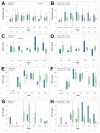Perioperative Vitamin C and E levels in Cardiac Surgery Patients and Their Clinical Significance
- PMID: 31505814
- PMCID: PMC6769782
- DOI: 10.3390/nu11092157
Perioperative Vitamin C and E levels in Cardiac Surgery Patients and Their Clinical Significance
Abstract
Background: Oxidative stress contributes to organ dysfunction after cardiac surgery and still represents a major problem. Antioxidants, such as vitamins C and E might be organ protective.
Methods: The primary objective of this prospective observational study was the description to evaluate the perioperative vitamin C and E levels in 56 patients undergoing cardiac surgery with the use of cardiopulmonary bypass. The association of vitamin C with inflammatory reaction, oxidative stress, organ dysfunctions, and clinical outcomes were evaluated in an explorative approach.
Results: Vitamin C levels decreased significantly from 6.5 (3.5-11.5) mg/L before surgery to 2.8 (2.0-3.9) mg/L 48 h after surgery (p < 0.0001). Fifty-six percent of patients had a suboptimal vitamin C status even before surgery. In protein-denaturized probes, significantly higher vitamin C concentrations were detected (p = 0.0008). Vitamin E levels decreased significantly from preoperative level 11.6 (9.5-13.2) mg/L to 7.1 (5.5-7.4) mg/L, (p = 0.0002) at the end of cardiopulmonary bypass, remained low during the first day on ICU and recovered to 8.2 (7.1-9.3) mg/L 48 h after surgery. No patient was vitamin E deficient before surgery. Analysis showed no statistically significant association of vitamin C with inflammation, oxidative stress or organ dysfunction levels in patients with previously suboptimal vitamin C status or patients with a perioperative decrease of ≥50% vitamin C after surgery. Patients with higher vitamin C levels had a shorter ICU stay than those who were vitamin C depleted, which was not statistically significant (72 versus 135 h, p = 0.1990).
Conclusion: Vitamin C and E levels significantly declined intraoperatively and remained significantly reduced low for 2 days after cardiac surgery. The influence of reduced serum levels on the inflammatory reaction and clinical outcome of the patients remain unclear in this small observational study and need to be investigated further. Given vitamin C´s pleiotropic role in the human defense mechanisms, further trials are encouraged to evaluate the clinical significance of Vitamin C in cardiac surgery patients.
Keywords: ascorbic acid; cardiac surgery; critical care; observational study; organ failure; prospective study; vitamin E.
Conflict of interest statement
The authors declare no conflict of interest that may be perceived as inappropriately influencing the representation or interpretation of reported research results.
Figures







References
Publication types
MeSH terms
Substances
Grants and funding
LinkOut - more resources
Full Text Sources
Medical

